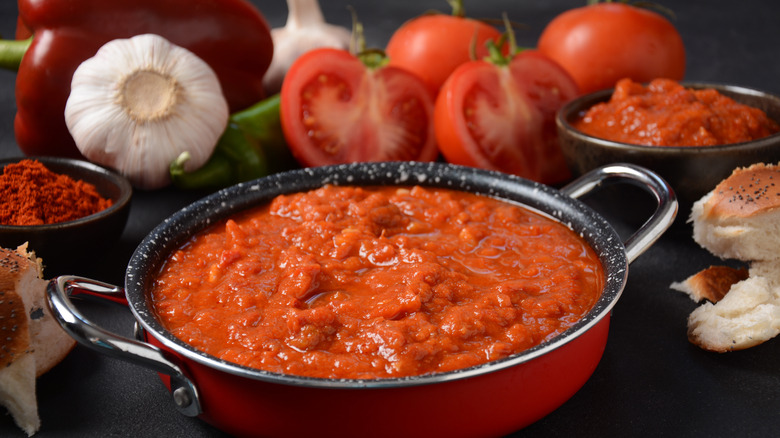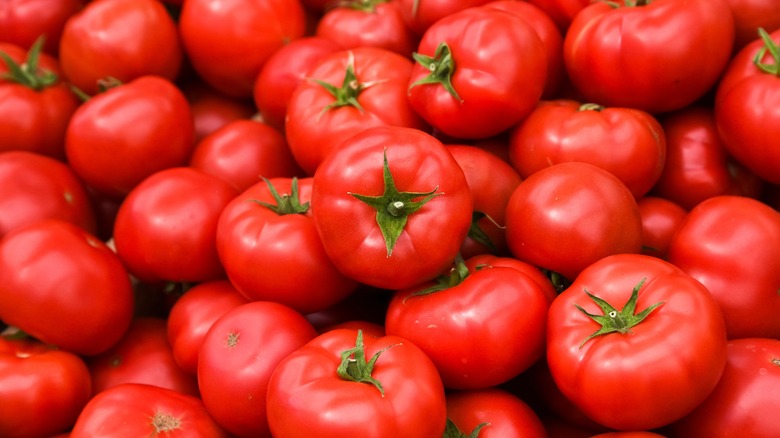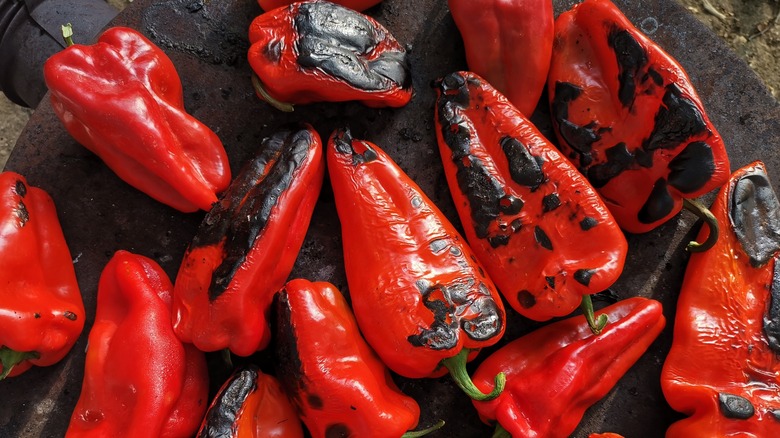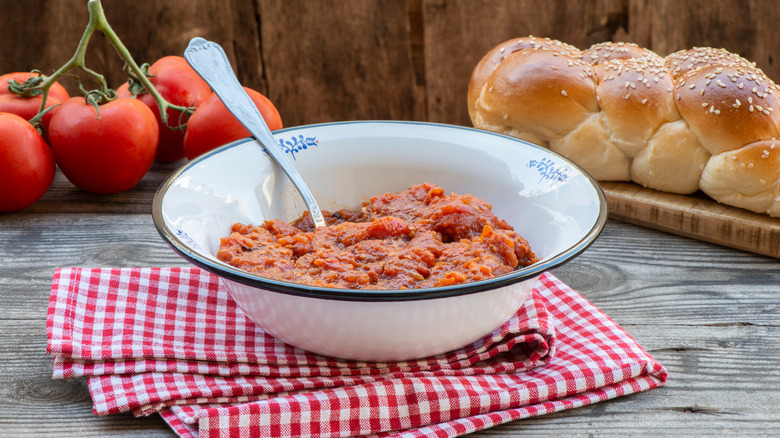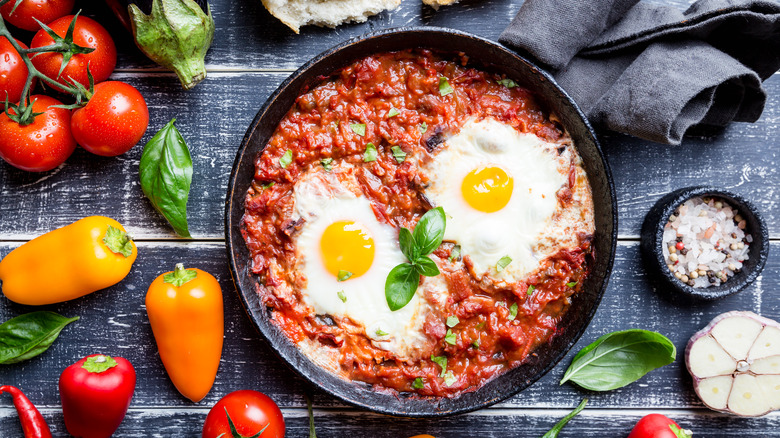The Moroccan Pantry Staple That Can Replace Fresh Tomatoes
Tomatoes are a staple of so many cuisines and recipes — from spaghetti with marinara sauce to chips and pico de gallo — that you would be hard-pressed not to find tomatoes in most household pantries. Whenever tomato season comes to a close, however, fresh tomatoes begin declining in quality, tasting less like juicy, umami flavor bombs and more like mealy water balloons. At times like these, it can be nice to have a jarred alternative available that will provide just as much flavor and texture as tomatoes do at their peak, if not more. Enter matbucha.
Matbucha is a bright and tasty concoction enjoyed in the Middle East and North Africa. While it is most commonly referred to as a tomato salad (the word matbucha in Arabic even means "cooked salad"), there are some who consider it closer to a condiment or a dip. Regardless of what category you put it in, this fresh and flavorful staple uses a heavy quantity of tomatoes as its base, making it a punchy and convenient shortcut when fresh tomatoes are unavailable or simply too far past their prime.
The history of matbucha
Matbucha is thought to have come about during the 1500s as a way to preserve the surplus quantities of tomatoes that traders brought back to Morocco from the western hemisphere. By cooking the tomatoes and adding spices, the people of North Africa were able to extend the length of time for which they could enjoy the produce before it decreased in quality or became unsafe to eat.
The spread of matbucha to other countries in the broader Mediterranean region is credited to Jewish immigrants who brought the dish with them during their travels. As such, the composition of the salad — and the way in which it is enjoyed — tends to vary based on the location in which it is made and the subculture by which it is cooked. This trait can make it an exciting dish to try multiple times, since you can pick up on interesting nuances with each version you taste.
How is matbucha made?
The standard ingredients for matbucha include red bell peppers, garlic, olive oil, and, of course, many tomatoes. The first step in making the dish is to char the peppers, after which you can peel them and remove or keep the seeds depending on how spicy you'd like the end result to be. These peppers are then combined in a pot with blanched and peeled tomatoes and the remaining ingredients, and the whole thing is cooked down until the matbucha reaches a jammy, spreadable consistency. Once it is ready, it can either be enjoyed fresh or poured into a sealable jar for storage in your pantry.
Like any beloved regional dish, iterations of matbucha vary in their additions and seasonings beyond the basic recipe. The type of peppers used can be changed to suit individual preferences, ranging from sweet bell peppers to hot jalapeño or Serrano peppers, or a combination of several varieties. Paprika is commonly added, as well as onions. This flexibility gives those who wish to cook their own matbucha a lot of freedom with how they tailor the dip to their tastes.
What does matbucha taste like?
Given its similarities with tomato dishes of the same format around the world, you may find the flavors of matbucha to be quite familiar. It is all at once tangy, savory, and sweet, with a pungent bite from the addition of garlic and a satisfying heat from the peppers. The spice level of matbucha will vary widely depending on the peppers used and the inclusion or exclusion of seeds during cooking, so prepare yourself for a surprising kick when trying a new batch.
In terms of texture, matbucha is very soft, bordering on liquidy — you will certainly want to enjoy it with a spoon. This is why some people refer to it as a dip or spread as opposed to a salad. The vegetables in this dish are cooked until they melt in your mouth, making for a luxurious, lasting bite that will keep you returning for more.
How to buy and cook with matbucha
When it comes to stocking your pantry with matbucha, the search is on. Unless you are in its region of origin, it's unlikely that you'll find it at your local grocery store. If you have shops that focus on Middle Eastern or North African cuisine in your area, they may have jars of matbucha on offer or be able to order some on your behalf. It is easiest, however, to simply purchase it online from a specialty vendor — the most notable being New York Shuk.
Given its flexible identity as everything from a sauce to a side dish, you can use matbucha any way you would usually use fresh or canned tomatoes, provided you're okay with the added spice. On the simpler side, we recommend slathering it on toast or stirring it into your morning eggs. For something a little more advanced, try using it in a fire-roasted shakshuka. Matbucha makes for an unusual yet exciting pasta sauce or pizza base, too, and a single spoonful amps up the flavor of any soup, salad, or sandwich. In short, get creative.
